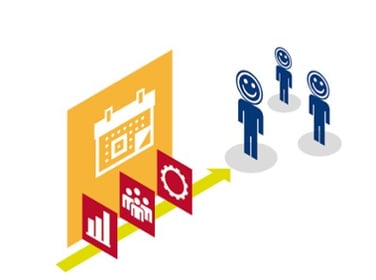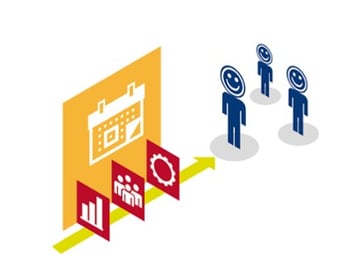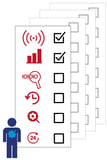How (and Why) to Improve Your Forecasts with Demand Sensing
Brian Hoey - December 04, 2018

 Baseball may not be the most popular sport in many parts of the world, but when one considers all of the analytical and statistical breakthroughs the game has made in the past two decades, it really deserves to be a favorite of supply chain managers in the Industry 4.0 era. Since the dawn of the “Moneyball” era, scouts, commentators, and prognosticators have developed new, increasingly complex ways of measuring past performance and forecasting future outcomes. Because everything that happens in the game of baseball, from a stolen base to an outfielder dropping the ball, can be represented numerically, entire seasons can be simulated in granular detail, and insights can be gained from those simulations. By integrating these systems with real-time game data, we can now make an ongoing estimate of the win probability of each team in the middle of each contest.
Baseball may not be the most popular sport in many parts of the world, but when one considers all of the analytical and statistical breakthroughs the game has made in the past two decades, it really deserves to be a favorite of supply chain managers in the Industry 4.0 era. Since the dawn of the “Moneyball” era, scouts, commentators, and prognosticators have developed new, increasingly complex ways of measuring past performance and forecasting future outcomes. Because everything that happens in the game of baseball, from a stolen base to an outfielder dropping the ball, can be represented numerically, entire seasons can be simulated in granular detail, and insights can be gained from those simulations. By integrating these systems with real-time game data, we can now make an ongoing estimate of the win probability of each team in the middle of each contest.
In baseball, this has become big business. But something similar is also happening in the modern supply chain. Our analytics processes are stronger and more evolved than ever, and we’re increasingly able to gain legible, real-time data from various supply chain processes (like production plans and transport routes). This has led to the rise of demand sensing in modern forecasting workflows. But what is demand sensing, and why should you care?
Why Demand Sensing?
Hopefully the end of the last paragraph wasn’t too much of a cliffhanger. Simply put, demand sensing is the process of utilizing real-time data from all points up- and down-stream in the supply chain to create a dynamic demand forecast. Why is this important for supply chain managers? Well, let’s compare it to the alternative: each year, your company bases its forecasts for the coming months on the market behavior of previous years, assuming that the same customers (or their equivalents) will make roughly the same order at roughly the same times. In this paradigm, your reliance on past demand makes it impossible to account for the myriad factors that affect demand levels in the real world—from weather forecasts to shifts in global currency to news and politics. As a result, there’s likely to be a significant gap between expectations and reality, and you might have costly stock overages taking up unnecessary warehouse space, or shortages that send your production programs into disarray.
With demand sensing, supply chain managers have the chance to narrow that gap between expectations and reality. By running predictive analytics algorithms and advanced simulations on massive caches of data updated on a real-time basis, this new paradigm has the power to increase forecast accuracy. The expected result here is more efficient production planning, inventory management, and transport logistics owing to the decreased potential for disruption and increased certainty with which plans can be undertaken. To think back to our baseball analogy, instead of taking the Vegas odds at the beginning of each month or quarter, you have the equivalent of live shifts in win probability informing your decisions on an ongoing basis.
Real-time Integration
Okay, so the value of demand sensing for improving forecast quality has been pretty well established, the question now is: how do you implement demand sensing capabilities into your own supply chain? Unsurprisingly, the most crucial step is implementing real-time information sharing into your planning and forecasting processes. This is often easier said than done. Because real-time integration depends on easy access to mission critical data, it requires the breaking down of information silos both within your organization and outside of it. In order to break down those silos, you may need to reexamine your existing IT infrastructure, rooting out Shadow IT and legacy systems that can’t integrate effectively with your overall ERP. Going forward, any solutions you do adopt (and any other companies you choose to partner with) will have to prioritize increasing connectivity and centralizing information into an accessible location.
Not only should planners be able to access data from production streams, inventory workflows, and transport logistics processes, they should also be able to access similar data from your suppliers (this may require a certain amount of IT integration connecting your internal systems to other businesses spread across your value chain). With this information accessible, you can combine it with live traffic and market data streams, thereby creating a framework in which your predictive algorithms have enough information to create a dynamic picture of future demand.
S&OE
Real-time integration for the purpose of creating a demand sensing workflow may seem like it is largely an IT question, but in point of fact it is just as much a question of organizational philosophy. After all, dynamic, high-quality forecasts are only useful to the extent that they inform business decisions and operational strategies. Because these new and improved forecasts operate on a rolling basis, changing over the course of the day or week, traditional month- or quarter-long operational planning cycles aren’t well-equipped to maximize the value of these forecasts. Instead, organizations that seek to gain the most added value from demand sensing need to be able to make small, daily adjustments to their inventory levels and transport plans to reflect changes in demand and thereby keep longer term plans on track.
As it happens, this process already has a name (coined by Gartner): sales & operations execution, or S&OE. With S&OE workflows in place, it’s possible for manufacturers to bridge the gap between day to day supply chain operations and longer term operational planning, helping to prevent short term deviations from expectations from accumulating into large scale disruptions. Crucially, S&OE planners also provide every touchpoint within your corporate value chain with an up-to-minute snapshot of real demand levels and future expectations. In this way, the whole team can coalesce around shared information and a common vision for upcoming operational goals, expectations, and challenges. This workflow, then, demonstrates the power of demand sensing to move beyond simple forecasting to empower broad operational improvements.
LATEST POSTS
- Understand Circular Economy in The Manufacturing Industry
- How Can Industry 4.0 IT Integration Be Achieved Smoothly?
- The Significance of Order Sequencing in Discrete Manufacturing
- How to improve your Supply Chain Management: The Power of Control Towers
- Optimizing Human Resource Scheduling in Manufacturing: A Technological Approach



